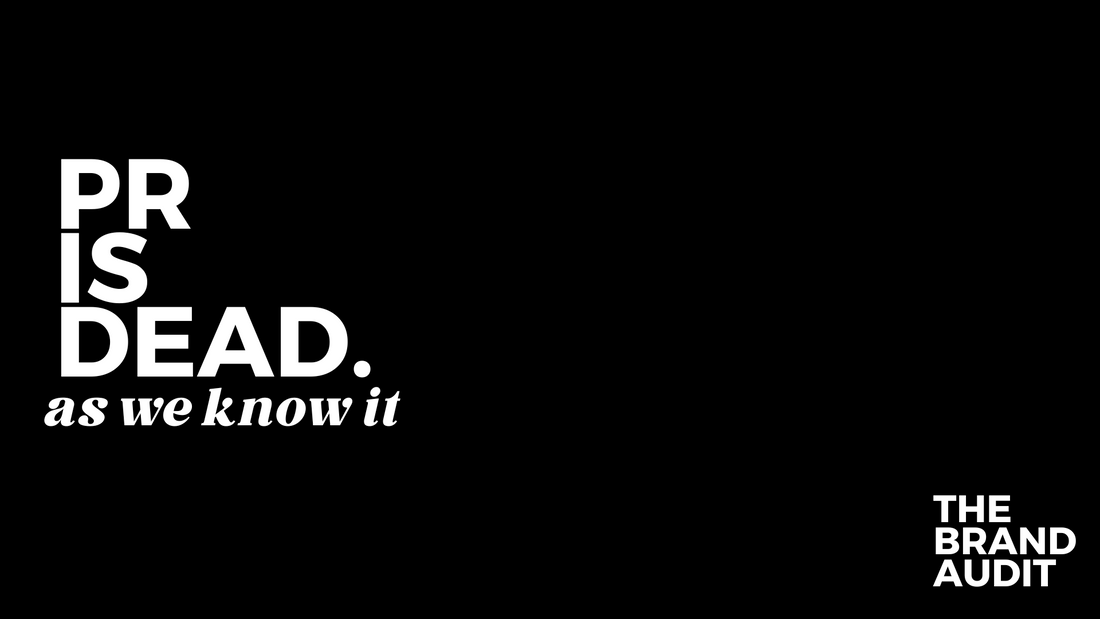I'm going to be contrarian and say PR is dead.
Or at least the traditional version of PR as we know it.
Enter the modern era of PR.
One that is founded on brand, engrained in social, cemented in collaboration, amplified by relationships and thrives on fastvertising.
As I help clients navigate the complexities of the modern business landscape, it becomes increasingly evident that the conventional methods of PR are no longer drivers of success.
How we engage with news, how we form opinions and how we share those opinions has radically changed.
As we saw with the recent Stanley incident a TikTok can garner more impressions than a prime time TV spot if brands are quick.
Let's explore the reasons behind the fall of traditional PR and the rise of modern PR.
Control to Collaboration:
Traditional PR operates on a model of control. A model of one-way dialogues. A model where organizations control the message and distribute it to the public through mass media channels with press releases, media kits, and spokesperson interactions with limited engagement with the audience. However, the digital age has ushered in an era of collaboration, where consumers expect to engage and have access to informal two-way dialogue with brands.
When hiring your head of PR you need someone that is going to establish those relationships and view them in a long term way which is why brand marketers are well-suited.
Media to Creator Centric
Traditional PR focuses on transactional pitches to journalists and traditional media outlets such as newspapers, magazines, and television.
But merely landing a news story doesn't cut it anymore. To truly succeed, PR teams need to adopt an integrated, social-first strategy to amplify their narrative.
Modern PR is more relationship driven. Now everyone is a potential journalist in the age of smartphones glued to hands and eyes glued to TikTok. News spreads at an unprecedented pace through UGC (user-generated content), and influencers hold significantly more sway with what makes the news than the actual journalists.
Tight control over messaging is obsolete as the audience and the creators become the brand's voice. Brands must adapt by building authentic relationships with these key players instead of trying to give them a script or craft a narrative.
Polished Perfection to Raw Realness
Traditional PR obsesses over the details. Every aspect of a brand's image is polished - presenting an idealized version to the public. But modern consumers don't want ideal. They want real. They want raw. They are quick to detect and cancel any PR voices dripping with insincerity. They are quick to tune out if there's not anything interesting.
Genuine, human connections dominate. CEOs and Founders must invest in their personal brands IRL and digitally as those 1x1 interactions matter more than the canned copy they give for articles. Brands must be real, relatable, and willing to allow their executives to show their imperfections to build trust in this era.
Transitioning from Intuition to Analytics
In a PR past built on intuition and experience - the new era demands the data be served. Analytics and metrics play a crucial role in understanding audience behavior, measuring success, and making informed pivots. Most traditional PR leaders do not have training on data analysis and that is why hiring someone with a social media background who is used to large data analysis can be a huge organizational win.
Storytellers take the stage
Consumers aren't interested in traditional press releases hearing about a company's new products or investments or milestones. They want an interesting story. Modern PR people find ways to tell that brand story and create interest that taps into current culture zeitgeist and dialogues.
Communication professionals often struggle with storytelling, as their training tends to emphasize detailing facts, dissecting details, and avoiding hyperbole which can hinder the natural flow and engagement that effective storytelling requires. Brand marketers prioritize crafting narratives that connect with people on a deeper level, fostering stronger brand affinity and engagement. The emphasis on emotional appeal, creativity, and customer-centric storytelling can contribute to a more compelling and resonant PR style.
Adapting to the Blink-and-Miss Pace
In a world where TikTok trends vanish in 3 days, PR must move at high velocity. Traditional PR is too slow. Communications professionals are lacking real-time responsiveness. They over analyze and under react. Instead of hiring traditional communications professionals, brands need to be hire digital-first marketers to run their PR team enabling them to be nimble, adaptive, and embrace innovation to stay ahead of the curve. If not ready to go full innovation, try splitting out your PR function where one half of the team focuses on disruption and the other half focuses only on crisis communication.
Overall the demise of traditional PR signals a shift towards collaboration, authenticity, data-driven decision-making, and adaptability. With that we need to overhaul tools, ditch old paradigms, revamp processes and crucially, hire people with a fresh perspective for PR.
_________________________________________________
Liked this Content and Want More?
Join The Brand Audit Club — a community for CEOs, Founders and Execs for more bespoke, personalized and in-depth content. Sign up for our Stop The Scroll Email Newsletter: A newsletter that makes you aware, question, think and better.
____________________________________________________________
Need bespoke help with your Personal Brand Strategy?
We have 1-1 and team personal brand strategy packages for CEOs, Founders and Executives. Contact Us to Unleash your Brand's Potential.
